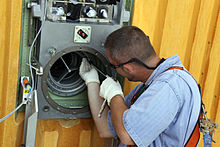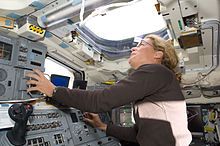STS-127
[4] Together they represented all ISS program partners[5] and tied the general record of thirteen people in space with the first such occurrence of 1995.[7][8] The Ground Umbilical Carrier Plate (GUCP) on the external fuel tank experienced a potentially hazardous hydrogen gas leak similar to the fault that delayed the Space Shuttle Discovery mission STS-119 in March 2009.[8] The second launch attempt on June 17, 2009, was also scrubbed due to hydrogen leak issues seen from the Ground Umbilical Carrier Plate.[NASA 2][12] A successful tanking test for leak checks was performed on July 1, 2009, with modified GUCP seals allowing launch preparations to proceed as scheduled.[16] Endeavour carried a wide variety of equipment and cargo in the payload bay, with the largest item being the Kibō Japanese Experiment Module Exposed Facility (JEM EF), and the Kibō Japanese Experiment Logistics Module – Exposed Section (ELM-ES).Also inside the payload bay was an Integrated Cargo Carrier-Vertical Light Deployable (ICC-VLD), containing a variety of equipment and spare components for the station.A set of experiments to be deployed on the ISS were carried by STS-127, including Dosimetry for Biological Experiments in Space (ESA), Validation of Procedures for Monitoring Crew Member Immune Function, the student-made Image Reversal in Space (CSA/ISU), Nutritional Status Assessment (NASA), NASA Biological Specimen Repository and Tomatosphere-II (CSA).[19] The docking module was also mounted with the DragonEye 3D Flash LIDAR ranging system manufactured by Advanced Scientific Concepts, Inc.The module was launched to test the docking system which will be used by the commercial SpaceX Dragon re-usable cargo carrier to send supplies to the ISS during the post-shuttle era.[22][NASA 7] The crew of STS-127 arrived at Kennedy Space Center on June 2, 2009, for the Terminal Countdown Demonstration Test (TCDT) that concluded with a full launch dress rehearsal.[11] Following the launch scrub, Chairman of NASA's Mission Management Team LeRoy Cain noted that engineers would work to understand the hydrogen leak issue and come up with a solution to the problem.[25] On July 1, 2009, the shuttle managers conducted a new series of tanking tests to confirm a hypothesis that a misaligned vent port housing was the root cause of the leaks.The existing rigid seal was replaced with a flexible one in the hope that it would maintain a tight fix even under the cryogenic conditions that seem to cause the leak.[36] The chairman of the Mission Management Team was not concerned and felt that the Space Shuttle would be cleared for re-entry on its return voyage—which it was a few days later.[37][38][NASA 11] The payload doors were opened after reaching orbit followed by deployment of the Ku band antenna and activation of the shuttle's mechanical arm.[39][NASA 12] The shuttle successfully docked with the station 220 miles (350 km) above the Earth, following rendezvous pitch maneuver (RPM) photography of Endeavour's thermal protection system by the Expedition 20 Crew.The docking happened on the ISS's PMA-2 (Pressurized Mating Adapter) on the Harmony module and the hatch was opened after leak checks.[15] EVA 1 started with astronauts Dave Wolf and Tim Kopra switching their spacesuit power to internal battery at 16:19 UTC.The spares were handled by Wolf riding the station's robotic arm to the P3 truss stowage platform where he and Marshburn attached them for long-term storage.The spares unloaded include a Ku-Band Space-to-Ground antenna, a pump module for the coolant system and a drive unit for the station's robotic arm's mobile transporter.After the experiments, containing an X-ray astronomy payload, a space environment monitor and a communications system, are installed the pallet will be returned to Earth by the shuttle.Meanwhile, Wolf removed obstructions, consisting of a steel handrail and an equipment installation socket, from the Harmony node to clear the way for an upcoming Japanese automated resupply ship.The three experiments, transferred from the Japanese cargo pallet, consisted of Monitor of All-sky X-ray Image, Inter-orbit Communication System and Space Environment Data Acquisition Equipment-Attached Payload.[NASA 25][67][68] The OBSS was grappled by the shuttle's robotic arm and used to inspect Endeavour's thermal protection system for damage from orbital debris.












Space Transportation SystemCOSPAR IDSATCAT no.Space ShuttleEndeavourMark L. PolanskyDouglas G. HurleyChristopher J. CassidyJulie PayetteThomas H. MarshburnDavid WolfTimothy KopraKoichi WakataKennedyLC-39ASLF Runway 15GeocentricLow EarthPerigee altitudeApogee altitudeInclinationPeriodSpace Shuttle programSTS-125STS-128ISS assemblyInternational Space StationJapanese Experiment ModuleISS programDiscoverySTS-119Lunar Reconnaissance OrbiterAir Force Eastern RangeGround Umbilical Carrier Platebeta angleanvil cloudslightningloss of ColumbiaKennedy Space CenterPositionExpedition 20Robert Thirskperson to fly in spaceIntegrated Cargo CarrierP6 trusspicosatellitesTexas A&M UniversityUniversity of Texas at AustinUnited States Department of DefenseNaval Research Laboratorylow Earth orbitatmosphereSpace Surveillance NetworkArduinoGreat LakesOne Drop FoundationBeethovenFifth SymphonyMontreal Symphony OrchestraSpaceX DragonSpaceXKibō JEM Exposed FacilityKibō ELM Exposed SectionOrbiter Boom Sensor SystemCanadarmChallengerColumbiaLaunch Pad 39ASTS-400rescueLaunch Pad 39BTerminal Countdown Demonstration Testexternal tankflare stackLeRoy CainT-minusPeter NickolenkoKu bandshuttle's mechanical armflight deckberthingKibō laboratoryExternal Stowage PlatformMonitor of All-sky X-ray ImageLithium HydroxideProgress 34DRAGONSatcarbon dioxidespacewalksDavid A. WolfOrbital Replacement UnitsGemini programApollo 15These Are Days10,000 ManiacsHere Comes the SunThe BeatlesMark PolanskyMarc BroussardLearning to FlyTom PettyChristopher CassidyBarry GrayLife Is a HighwayRascal FlattsTom MarshburnSanta MonicaEverclearDouglas HurleyTiny DancerElton JohnWish You Were HerePink FloydIn Your EyesPeter GabrielDixit DominusGeorge Frederic HandelOn the Sunny Side of the StreetSteve TyrellGod Bless the U.S.A.Lee GreenwoodChris CassidyYellowColdplayDoug HurleyI Got You Babe